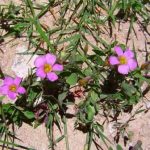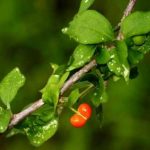TREE LIFE
May 2004
Annual subs are now due. Prompt payment would be appreciated.
$5000 for Tree Life by email or $10000 by post
Dear Tree Society members
It is so sad to have to tell you that Maurice Graves died on Sunday 6th June. There will be a Requiem Mass in his memory at Nazareth House on Friday 11th June at 10.30 am.
Kind regards Maureen S-J.
MASHONALAND CALENDAR
Saturday 1st May. Botanic Garden Walk. Meet Tom in the car park at 10.45am for 11. Today’s topic will be several small families which have not been covered before on these walks, such as loganiaceae (strychnos) and cornaceae (curtisia)
Sunday 9th May. AGM at Thetford Estate.
Tea will be served at 9.30am and the meeting will begin at 10.00am. Please bring a plate of eats to share for tea and bring your chair. Please bring a picnic lunch as usual.
After the meeting our host Mr. Mark Brightman will lead us to a suitable spot for our walk.
Sunday 16th May. Natural Riches of the Eastern Districts – presented by the Aloe and Cactus Society in the educational centre of the Botanic Gardens. Starting at 8.00am and covering many subjects with some well known speakers. For bookings and further information tel: 884003 or 747218 or 339175.
Saturday 22nd May. Mark’s Walk will be at Mr and Mrs Copcutt’s small holding in the suburb of Kambanji. We will meet at 2.30pm as usual.
Saturday 5th June. Tom will be away for the next three months but Meg Coates Palgrave has kindly offered to lead the walks in his absence.
MATABELELAND CALENDAR
Nothing has been arranged for May.
CHAIRMAN’S REPORT TO THE AGM ON MAY 9th 2004
I have pleasure in presenting the Chairman’s report for the year since the last AGM in May 2003.
General
When I sat down to write this report, I re-read the opening paragraph of the 2003 report and thought why not just change 2003 to 2004 and reprint it? – since so many of the problems we are facing are the same.
During the year under review, inflation soared to over 600% per annum, negative real interest rates continued to batter our savings, fuel shortages characterised most of the period and once again, commercial farms were generally unavailable for visits.
To this happy catalogue, one could also add the dire shortage of cash, which nearly caused us problems on our trip to the Vumba.
However, once again, the Society has managed to keep going and even thrive. Sadly, I suspect that the 2005 report will be much the same again as the problems are deeply entrenched.
Outings
During the year, a full complement of main 3rd Sunday outings was held; these were at Rob and Gillian Smith’s home in Harare (the AGM), Arcturus (twice: Darryl Tiran and Kevin Fallon), Gwaai Farm near Wedza, Mitchell and Mitchell at Marondera, Lake Chivero, Umwindsidale (Eleanor and Norman Dickens), Domboshawa (twice!), Crest Farm and (to come) Mazvikadei. We are most grateful to the various landowners (or their representatives) for giving us permission to visit and to the leaders of our walks for their time and knowledge.
A fascinating longer trip was spent in the Vumba over the Heroes weekend in August. I am most grateful to John Bennett, Bart and Petra Wursten, Tackie Bannerman, Werner Fibeck and Meg Coates-Palgrave for their assistance on that trip.
Once again, Tom Muller each month gave us his time to lead us in the Harare Botanic gardens. Subjects covered included Acacia, Albizia, Annonaceae, Boraginacae, Flacourtiaceae, Lamiaceae, Sapotaceae and Verbenaceae. We are very fortunate indeed to have someone of his calibre. I am also very grateful to Meg Coates-Palgrave who stood in for Tom while he was on holiday and extended our horizons to South African trees.
A nearly complete set of 4th Saturday walks was led by me at which we explored not only the trees but also the weeds and exotic trees.
Other functions
Three informal evening functions were held during the year. Lyn Mullin spoke on Eucalypts, Adele Hamilton-Ritchie on the Indian city of Hampi and Fr Brendan Conway on his trip to Kilimanjaro and Ruwenzori in 1962. Our great thanks go to our speakers and our hosts.
In February 2004, Bob Drummond achieved his 80th birthday and a small informal gathering of members was held at Eva Keller’s home.
Matabeleland branch
Once again, this has been quiet during the year.
Membership
The current membership, compared to previous years, is as follows:
| MEMBERSHIP | 2004 | 2003 | 2002 | 2001 | 2000 | 1999 |
| Ordinary Members | 159 | 158 | 188 | 204 | 218 | 201 |
| Associate Members | 5 | 7 | 14 | 14 | 14 | 14 |
| Honorary Members | 6 | 8 | 9 | 8 | 8 | 8 |
| TOTAL | 170 | 173 | 211 | 226 | 240 | 223 |
It may be seen that although the membership has once again fallen, the dramatic declines of the last 3 years have been arrested.
A particular source of new members has been the Twinarts emails and I’d like to thank Linda Hyde for systematically keeping those up to date.
We report with sadness the death of 4 members during the year. The death of Lyn Mullin, our Deputy Chairman, was a great blow and we will miss his wise counsel. Mrs Aylen, the wife of the late Doug Aylen, who was a key member of the Society and a former Chairman, passed away during the year as also did Nino Bianchi and John Smart.
Some members also emigrated during the year: the DuPlessis’s to Zambia, Mrs Dudhia to Bangladesh and Mrs Hurley to South Africa. In all cases, however, they have remained members.
Tree Mapping
The Tree Mapping exercise is currently on hold.
Tree Life
Perhaps the major effort of the Society is the production of our monthly Newsletter. Most of the hard work falls on Maureen and I am very grateful to her for her hard work. Vida Siebert continued her behind the scenes work of collation and I would like to thank her as well. Lyn Mullin was also a major contributor to Tree Life and we shall miss him very much in that regard. John Lawrence has been of great assistance in writing up our outings.
Tree Life is also our major cost and we were faced with either cutting back and sending it out less frequently than monthly or raising subs to unacceptable levels. The solution has been, where possible, to send out Tree Life by email, which although not ideal in some ways, has effectively saved the Society.
Finance
The year under review was another difficult one financially. However, we have continued in existence by cutting costs and through many generous donations.
During the year, Terry Fallon took over as Treasurer and we are very pleased to welcome him to the post.
Publications
Lyn Mullin’s book Historic Trees of Zimbabwe appeared in 2003 and has been a great success. Also, Lyn’s list of vernacular names of Zimbabwean plants was completed in draft by the time of his death and the Society intends to publish it during the year.
The Mweb web site has been maintained on a regular basis by Odette Lind and we are very grateful to both Odette and Mweb for their support.
Purpose of the Society
The Committee also considered what the function of the Society should be. Are there things that we should be doing which we are not? Should we not perhaps be more focussed on specific projects? Or are we happy to continue as we are? Perhaps this issue could be discussed at the AGM.
Finally,
I would like to thank the Committee for their hard work and support during the past year.
Mark Hyde Chairman
BOTANIC GARDEN WALK: 2 MARCH 2004
No specific subject had been chosen for this walk and it was agreed that we would simply look at any trees of interest. It was very nice to meet again two unexpected visitors namely the Duplessis’s, who were back in Zimbabwe on a short visit from Zambia where they are now farming.
The following is just a selection of the many species we saw.
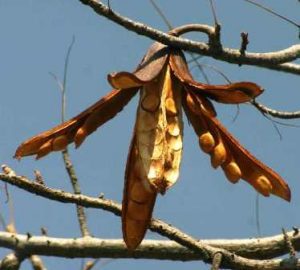
Entandrophragma caudatum. Photo: Bart Wursten. Source: Flora of Zimbabwe
Tom mentioned that the species in the genus Entandrophragma often have nice wood and this is true of our sole Zimbabwean species, Entandrophragma caudatum (the Wooden banana). Mabberley tells us that there are 11 species in the world, all of which are tropical African, and many have wood which is used as a substitute for true mahoganies. Specifically, E. candollei, E. angolense, E. cylindricum and E. utile. In our species, the leaves are 1-pinnate and glossy and the leaflets have drip-tips. A striking and famous Acacia is A. erioloba (formerly A. giraffae). This Kalahari sand species occurs in Namibia where it is the last tree you encounter before you reach the desert. The pods are a distinctive broadly curved shape; they have a very high protein content and are very important as fodder. In many cases, the trees themselves eventually become flat-topped.
An interesting species of Grewia was G. retinervis. This is a species occurring in gusu, i.e. Kalahari sand. Interestingly it has square stems like the very common G. flavescens. The flowers were yellow and relatively small and the leaves green beneath, slightly rough above and with an asymmetric base.
Later we saw Grewia flavescens. This species is rather larger in its parts than the more delicate retinervis, the angular nature of the stems is more pronounced.
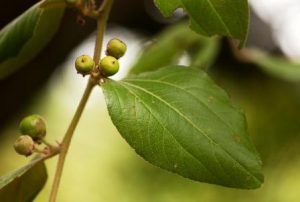
Ziziphus abyssinica. Photo: Bart Wursten. Source: Flora of Zimbabwe
Several times on the walk we passed Ziziphus abyssinica. This is a lowveld species, somewhat similar to the common one around Harare, Z. mucronata, but with deeply impressed veins and larger leaves. Oddly we saw it in January in the Mukuvisi Woodlands by Blatherwick Avenue, where, presumably it was planted. There it grows with a marula (not really native to the Harare area), Dalbergia sissoo (a definite alien) and a clump of Phyllanthus reticulatus (again not really occurring where it should). The presence of all these species together further suggests that someone in the past has been busy planting unusual trees.
Erythroxylum zambesiacum was in fruit with numerous small red berries. Tom mentioned that this is a species of the jesse but also occurs in alluvium as well. As we have noted before the impression of the plant (if there are no flowers or fruits) is rather similar to Flueggea virosa, but the Erythroxylum has pendent branches and a distinctive peeling bark.
Dalbergia martinii is that extraordinary species which grows in the Zambezi valley which has sticky patches on the outside of it pods. It is also a sprawling, semi-climbing plant. The specimen in the Gardens was covered in pods and we were able to experience the stickiness first hand.
Finally, a common species, Vangueriopsis lanciflora. This was a smallish specimen but it showed very strongly and clearly the reddish-brown powdery bark that this species tends to have. This is a useful character to separate it from Vangueria infausta.
Once again, may I thank Tom for giving up his time to lead us through the Gardens.
-Mark Hyde
THE GREAT LEADWOOD AT SOMAVUNDHLA PAN
Out of this tree…long, long ago, at the very beginning of all things, came forth a man and a woman. The man was Mukuru, the first ancestor, and the woman was Kamungundu. From them came the Herero, the Ovambo, the Ovatyaona…and the Nama. The oxen, too, came out of the sacred Omumborumbonga tree, but the sheep and goats came from underneath a flat stone.
PENNY MILLER (1979) – MYTHS AND LEGENDS OF SOUTHERN AFRICA
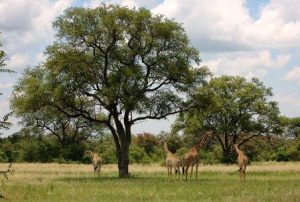
Combretum imberbe. Photo: Bart Wursten. Source: Flora of Zimbabwe
The legend of the ancestral tree of man and of the animals comes from Namibia, where the Herero people show great reverence towards the leadwood tree, Combretum imberbe, known in Afrikaans as hardekool. This legend is no part of the traditions of Zimbabwe, where the tree is common and well known for its extremely hard and heavy wood which burns to a markedly white ash, hence the Shona name, muchenarota. The Ndebele people call it umchenalota.
Well off the tourist route in Hwange National Park, at Somavundhla Pan, there stands a great leadwood that could, indeed, be the ancestor of all living things, if appearance is anything to go by. Leadwood is believed to be extremely slow growing, and a really large specimen could be more than a thousand years old. The tree at Somavundhla Pan had a diameter at ground level of 2.55 metres in June 1987, a height of 19 metres, and a crown spread of 23 metres. A little above ground level the main stem divided into three, and the largest of these was 1.11 metres in diameter. There are plenty of much taller specimens of its kind in Zimbabwe, but none is known with a greater diameter at the ground.
This tree has kept watch at the pan for untold centuries, and its bark has been worn smooth by the rubbing of countless wild animals that have drunk there.
-Lyn Mullin
CREST POULTRY FARM 21 MARCH 2004
The Tree Society Sunday outing in March was at Crest Poultry Farm, on the southern outskirts of Harare. There were 17 members and visitors, led by Rob Burrett. We parked our cars outside the main entrance boom and spent a rewarding day exploring a large block of indigenous woodland extending between the road and a wide vlei.
The area was granite sand veld, with occasional low outcrops of rock and a few large anthills. The dominant trees were Julbernardia globiflora and Brachystegia spiciformis, probably not more than 30 years old. They sheltered a surprisingly varied population of trees and shrubs that gave us plenty to study during the day. The woodland was heavily invaded by Lantana camara, which is always undesirable, but on this occasion it provided great splashes of colour that were very attractive. Although it was a hot and sunny day, the recent rains had left a legacy of a wide variety of fungi under the trees. None of the party had any claim to specialist knowledge of this family, and the general consensus was that they were probably all poisonous, with the exception of little red chanterelles, which Adele collected. There were also quite a number of small ferns.
The most unusual tree that we encountered was Commiphora africana, growing on a rocky outcrop. It was a small tree with velvety, trifoliolate leaves and spine-tipped branchlets. We did not notice the resin, which is supposed to be a diagnostic feature of the genus Commiphora. The smaller branches were irregularly thickened, which Rob explained was the result of parasitism by the larvae of Diamphidia beetles. These larvae feed exclusively on this species, and the pupae were used to make arrow poison by the San people; hence one of the common names, the Poison-grub Corkwood (why Corkwood?).
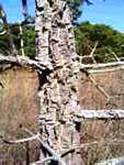
Strychnos cocculoides. Photo: Bart Wursten. Source: Flora of Zimbabwe
A much better candidate for the name Corkwood is Strychnos cocculoides, the Corky-bark Monkey-orange, of which we saw many examples. It closely resembles its more common relative, Strychnos spinosa, which we didn’t see, having three to five-veined leaves, spines, and large, round, hard-skinned fruit. The obvious distinguishing feature is the thick, ridged, corky bark. The fruit is speckled with white, not plain, and apparently is more tasty.
Given Rob’s special interest in trees with edible fruits, we were fortunate to find a number of different species in this category . Vangueria infausta, the Wild-medlar, and Vangueriopsis lanciflora, the False-medlar, were very common, although unfortunately not in fruit. Their close proximity gave us ample opportunity to practice our skill at differentiating them from each other; the leaves of Vangueriopsis have the midrib raised on the upper surface and therefore fold less easily along their length, but it’s rather subjective. They are more easily differentiated by their flowers and fruit, but in any case, does it matter if you can’t tell the difference? Around Harare they look alike, they grow in the same environment, and they both have edible fruit, so enjoy the fruit if you can find it! Other trees with edible fruit that we encountered were Ximenia caffra, Rhus tenuinervis, Diospyros lycioides and Ziziphus mucronata.
One tree that caught my eye, that I hope I can remember next time, was Ochna pulchra. The leaves were simple and not particularly characteristic, but the bark was. It was grey, rough and scaly at the base, but smooth, pale grey and peeling further up, revealing a delicate pink underbark, hence the common name Peeling-bark Ochna. The contrasting bark has given rise to the nickname Mermaid Tree, with a scaly tail and smooth pink shoulders.
While most of the woodland was fairly uniform, we encountered different tree associations in two distinct habitats. One was an antheap. The tree species that grow on antheaps tend to be those of a lower altitude than the surrounding bush. The species that we identified on the antheap and nowhere else were Flueggea virosa, Schotia brachypetala and Vangueria randii, the Antheap Wild-medlar, also edible. The other habitat was an area that had been cleared at one stage, possibly for use as a landing strip. Here we found Terminalia sericea and three pioneer Acacia species, A. ataxacantha, A. sieberiana and A. nilotica. Finally, on the edge of the vlei, we encountered two suffrutex species growing; Parinari capensis, which we see quite often, and a species of Vangueria that we could not identify.
We enjoyed a relaxed and sociable day in the open air, and hopefully came home knowing a little more about the trees of the Harare area than we had when we set out.
-John A Lawrence
PALMS Extracted from and acknowledged with thanks to the magazine of the Albany Museum. R.S.A.
The Phoenix August 1994. Vol 7.No 1.
A CAVALCADE OF COCONUTS By Estell Brink
Chief among the Cocosoid palms is that feature of all tropical beaches, the ubiquitous coconut which girdles the earth from Cancer to Capricorn. It was a mainstay in the survival of man, the tropical ape, and is still one of the most important sources of plant oil which is used commercially in the manufacture of soaps and margarines.
The generic name, Cocos, derives either from the Greek kouki for coconut or the Portuguese macoco, a kind of monkey, which relates to the monkey-face formed by the three scars on the end of every coconut. The latter is certainly more entertaining calling up, as it does, visions of generations of Doco the Clown trailing rosy clouds of childhood for all of us. These fruits, wrapped in swathes of coir, are designed for floating and they have used the highways of the ocean currents that circle the world to colonise the tropics and, in the process, have themselves adapted and changed so that botanists have been hard put to decide whether it is still one species or 60 as indicated by some authorities. The mother species, Cocos nucifera (the nut-bearing cocos) is the most commonly encountered and is actively cultivated for its manifold uses.
The trees are tall 9 up to 35 m and slender and seldom grow upright but lean at an angle towards the sun. Often this coincides with the shore-line and the coconuts that drop in the ocean are swept away to colonise new shores. No doubt this is an important dispersal mechanism but its propagation from island to island has nearly always been the deliberate work of men and its introduction to Sri Lanka is recent enough for it to be a matter of reliable legend. It is believed that it originated in tropical America and that men were probably responsible for its westward crossing of the Pacific. By the time the Europeans set out on their voyages of discovery, it was already a well-established crop of cultivation in Polynesia and Malaya.
Each tree is crowned by 16 – 20 pinnate leaves with reduplicate or A-folded leaflets and each leaf can be up to 6 m long. The flowers are male and female and are borne by the same inflorescence in triads in depressions on the branches. Each inflorescence can be 2 m long. Five to fifteen nuts are borne in each and fully grown trees produce 4 to 5 crops annually for up to eighty years.
It is commercially exploited for toddy in the Phillipines, Java and Sri Lanka and coir, as an article of commerce, comes chiefly from Sri Lanka. But these are secondary to the principle product, copra, which bears the valuable coconut oil of commerce. For many years it was the world’s single most important source of vegetable oil and it was to exploit this that the vast plantations were planted in the lowland tropical areas of the Phillipines, Oceania, Indonesia, Malaysia and Sri Lanka which together produce over 90% of the world’s coconut oil. In 1972 Purseglove reported that there were over 5 million trees on 10 million acres in these countries.
Copra is the dried flesh (or endosperm) of the Cocos seed and 65% of it is oil but the harvesting and preparation of copra is not amenable to mechanisation and this all important first step in the industry relies totally on hand labour. As the nuts need to be fully ripe before use one could theoretically wait for them to drop but the preferred method in the Phillipines is to cut them down by using a curved knife mounted on a long bamboo pole or by actually climbing the trees either by means of notches cut into the trunk or the ingenious use of a rope harness. In the Sunda Islands monkeys have been trained to do this job and Sarawak has occasionally exported these trained monkeys to other islands in a kind of latter day primate slave trade. However, these difficulties are only part of the reason why Cocos nucifera is facing strong competition in the oil-race by another Cocosoid palm, the oil-palm or Elaeis guineensis.
To be continued.
The planting of the Khaya anthotheca in Lyn’s memory went well at Forest Research Centre on Sunday afternoon 25thApril. More than 30 people turned up and I would like to thank you all for coming and giving your support.
Thank you from Anne Mullin.
MARK HYDE CHAIRMAN


